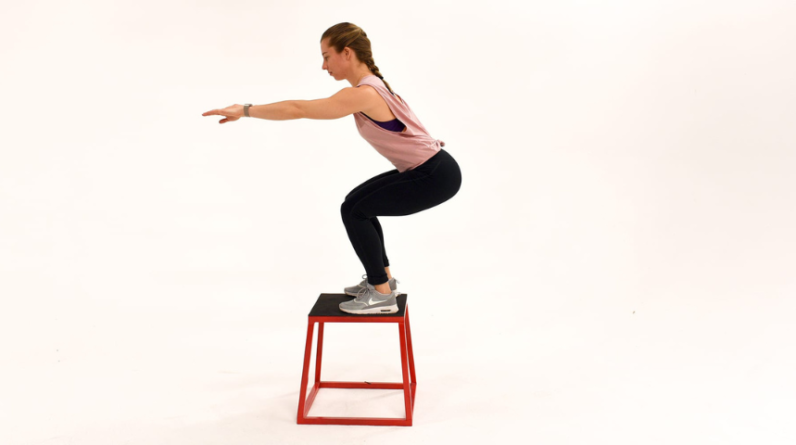
Box jumps have reached a tipping point in the fitness world. Walk into any gym, HIIT studio, or CrossFit box, and you’ll inevitably find someone repeatedly hopping on and off a box, step, or bench. The lure of the box jump is understandable; they’re a challenging and fun plyometric exercise, which, when done correctly, not only look cool, but also build explosive power.
But when box jumps go wrong, they have the potential to go really, really wrong. (Just Google “gym fails” for proof.) And even when box jump mistakes don’t end in an embarrassing fall, they can, over time, take a toll on the jumper and lead to chronic injury.
If you want to incorporate box jumps into your regular workout routine, it’s worth your time to first understand how to do them safely and effectively.
Box Jumps: Step-by-Step Instructions
Start with the appropriate box height — about knee-high or lower. While the viral videos of pro athletes clearing five-foot-tall boxes are impressive, Pete McCall, master trainer and author of Smarter Workouts: The Science of Exercise Made Simple, cautions against using box jumps to challenge your own vertical aptitude.
“The risk of injury is significant, whether it’s a blown Achilles tendon or falling off a box,” he says. Plus, jumping onto a box taller than knee height is more of a hip mobility exercise than a plyometric one.
- Stand facing the box (or other stable elevated surface) with your feet hip-width apart, and bend your knees into a quarter squat, bringing both arms behind you.
- Swing your arms forward and jump up and onto the box, landing with your knees bent and both feet on the middle of the box.
- Stand up, and then step down from the box one foot at a time. “Never jump off the box,” cautions Trevor Thieme, C.S.C.S., adding it’s not worth the impact on your joints. “The potential performance benefits don’t outweigh the increased risk of injury.”
It’s best to do box jumps after a quick warm-up at the beginning of your workout. After a cardio or strength session your leg muscles are more likely to be fatigued.
Thieme recommends keeping your sets at six to 10 reps and resting in between. “As with any power-focused exercise, you want to allow plenty of rest (one and a half to two minutes) between sets to maintain a high level of performance,” he says.
Muscles Worked by Box Jumps
Box jumps can build power, strength, and size in your lower body muscles:
Benefits of Box Jumps
No matter what you do in or out of the gym, box jumps provide loads of benefits.
Improve strength and power
“The box jump’s primary benefit is helping you build explosive power, which is an important skill in just about every sport — and in everyday life.”
Athletes of every sport and ability level — pick-up basketball players, beach volleyball pros, recreational road racers — can benefit from box jumps, as they target the body’s type II muscle fibers, McCall says.
“Type II muscle fibers are responsible for developing strength and explosive power,” he explains. “Box jumps are one of the best ways to do that because you’re performing rapid muscle action in a very short period of time.” If you want to jump higher, train for quicker leg turnover during a run, or just move faster in general, box jumps can help develop your power and speed.
Build and tone muscle
And if how you look in jeans is more important than your 5k time, box jumps can help there too.
“For people who want to work on their lower-body aesthetics, jumping is a great way to go,” McCall says. “Box jumps target the quads, glutes, and hamstrings, and they activate the type II fibers, which contribute more to muscle definition and size.”
How to Work Up to a Box Jump
If you’re new to box jumps, Thieme recommends starting with bodyweight plyometric exercises like squat jumps and split jumps.
Once you’re comfortable with basic plyometric training, you can try box jumps with a shorter box; even a platform that’s 12 inches or lower can offer a challenge while helping you develop the necessary strength and coordination for box jumps.
Thieme recommends including box jumps or other plyometric movements into your workout regimen two to three times per week. However, beginners should stick to a smaller rep scheme of no more than three or four consecutive jumps per set, according to McCall.







